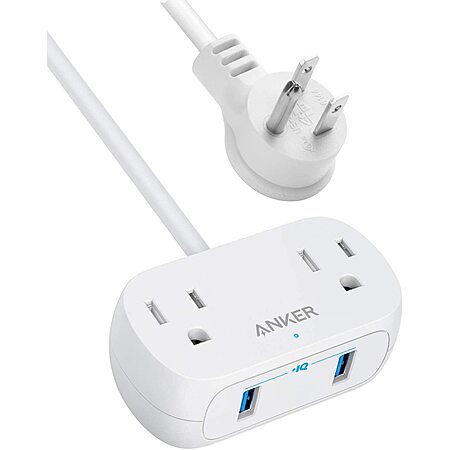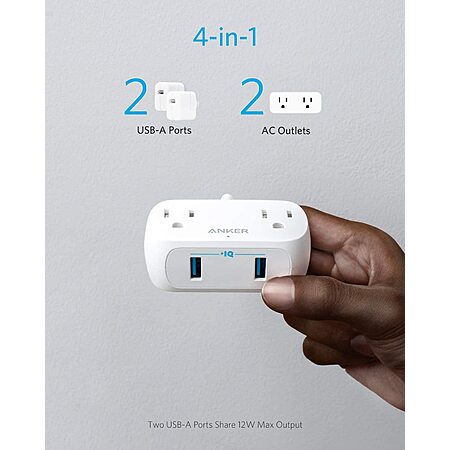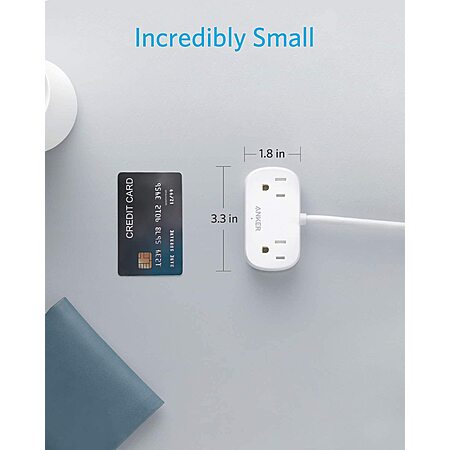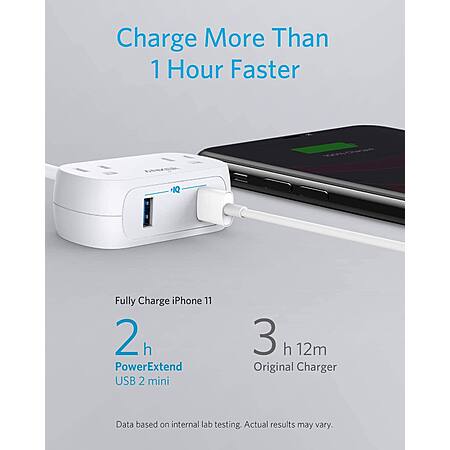expiredLovelyCheetah | Staff posted Oct 25, 2021 05:42 PM
Item 1 of 4
Item 1 of 4
expiredLovelyCheetah | Staff posted Oct 25, 2021 05:42 PM
30% Off on Anker Power Strip w/ PowerExtend USB 2 Mini (2 Outlets & 2 USB Ports) $10.49
$10
$15
33% offAmazon
Visit AmazonGood Deal
Bad Deal
Save
Share








Leave a Comment
14 Comments
Sign up for a Slickdeals account to remove this ad.
So not really a deal of any kind, just a shilled product from Anker. Anker, like Ugreen, has seemingly focused on using slickdeals as a primary marketing tool for moving product in their third party stores.
Good luck!
Jon
So not really a deal of any kind, just a shilled product from Anker. Anker, like Ugreen, has seemingly focused on using slickdeals as a primary marketing tool for moving product in their third party stores.
Good luck!
Jon
I've looked at Teardowns (internals) of 2-3 recent Anker products and I don't see anything bad. Step up from all the other random plugs recommended here without any certification at all.
I've looked at Teardowns (internals) of 2-3 recent Anker products and I don't see anything bad. Step up from all the other random plugs recommended here without any certification at all.
As such, I would not make any comparisons between, say, premium Anker USB chargers and their power strips. In fact, component selection for the power strips prove some of the inferior choices being made as the Anker power cords are typically 18 gauge wire, thinner than any choice you can find in a Home Depot extension cord aisle (for comparison).
Good luck!
Jon
As such, I would not make any comparisons between, say, premium Anker USB chargers and their power strips. In fact, component selection for the power strips prove some of the inferior choices being made as the Anker power cords are typically 18 gauge wire, thinner than any choice you can find in a Home Depot extension cord aisle (for comparison).
Good luck!
Jon
Most of the "premium" power adapters are power integrations template designs with random assortments of caps depending on what's cheaper at a given time. Even apple of all companies cant hold supply of Nicheon caps (Flextronics/SALCOMP/ETC) and has moved on to cheaper Aishi or what ever is available.
I'll have to disagree about 18AWG though. This is a standard choice for any high rated computer power supply sub 650w output. Going to a lower gauge wont really make a difference for essentially what is a USB hub... but I digress.
I mean sure.. you can find 14-16 AWG Strips at the local home depot but we're nitpicking here.
Edit: On that note, I'll always recommend that you use an OEM charger over a 3rd party brick/strip, but you can do much worse than Anker. Especially on Amazon.
I mean sure.. you can find 14-16 AWG Strips at the local home depot but we're nitpicking here.
For laypeople I'd note that these differences are bigger than they might sound. 18 AWG is 2/3 the cross-section of 16 AWG. 16 AWG is 2/3 that of 14 AWG. More cross section is more money (and copper isn't cheap), but also more safety margin.
Good luck!
Jon
I don't mean to suggest that no device plugged into power can safely operate on 18 gauge wire, just no device with accessory AC outlets - if this device only had USB ports 18 gauge wire would be more than sufficient. 18 AWG wire is termed lamp wire because most every lamp still uses it(!). However, a new extension cord / power strip should employ 16 AWG as a minimum, and preferably higher depending upon the application. This entire category of devices (integral USB chargers with accessory AC outlets) essentially identifies itself with the thinner than typical cord selection.
For laypeople I'd note that these differences are bigger than they might sound. 18 AWG is 2/3 the cross-section of 16 AWG. 16 AWG is 2/3 that of 14 AWG. More cross section is more money (and copper isn't cheap), but also more safety margin.
Good luck!
Jon
Were talking about a unit that is going to power a high end computer and USB accessories. The fact that a 2 plug + 2 USB adapter is the same, doesn't exactly bother me the same way, but I digress. (This should generally come down to total amps on 120V plug vs length.)
I actually did some research and it seems like Seasonic has fully switched to keeping 18AWG up until 850-1000W units. I believe they used to switch over to 16AWG after 750W threshold, but this might be a cost decision as other Taiwanese OEM's such as Superflower are doing the same for their own branded units.
Corsair seems like the only remaining company (they OEM units from multiple brands) that switches from 18AWG >16AWG past a 650W threshold on premium designs. The "low end" CX-F stuff is still 18AWG past 650-750W.
All things considered, I have mixed feelings. There is a level of cost down here in regards to modern PSUs, but 18AWG is generally "good" up until full 750W draw at the same time, at least in regards to EE/PM choices made.
Back to this Strip/Powerbrick, I still think were nitpicking, but if you can find a quality unit with better specs, UL/ETL/TUV certification at the same price, well.. no harm done.
Sign up for a Slickdeals account to remove this ad.
The key concept, driven by that cross-section size I mentioned, is ampacity: the maximum current a wire can carry. For a two-conductor 18 AWG cable of a short length (so not 100') this is generally pegged at 10 Amps. This labeling can be seen on some Anker devices that use 18 AWG cord, like their PowerPort Cube. For 16 AWG wire the rating is 13 Amps (check the rating on a lamp-cord style extension cord at Home Depot) and for 14 AWG that number goes up to 18 Amps (you may see that rating printed on the cord, though the associated power strips to which they are connected are typically only rated to 15 Amps).
This provides a safe margin for a computer power supply because if you consider the 750W power supply and assume 80% efficiency that's a peak draw of 750/.8=937.5W total draw / 120V = 7.8 Amps < 10 Amps. The difference between the two numbers is the margin of safety, which is actually made wider by the fact that the power supplies are usually much more efficient these days overall, and especially under max load (so a 1000W power supply at 90% efficiency is drawing just over 9 Amps). As an additional safety measyre, power supplies, like many electronic devices, also incorporate safety circuits to shut the device down should it attempt to go past certain limits. The closer you operate a conductor to its maximum the more likely you might overheat it, and temperature & length are important variables, but overall manufacturers aren't making significantly dangerous choices, just cost-conscious ones.
In contrast, an extension cord (without any kind of circuit protection technology) places no limits on what can be drawn. Lamp cord typically has the benefit of visually presenting the image of "don't get cute with what you plug in". As such, Anker's combination of 18 AWG wire and heavy duty-looking construction represent a bad combination.
A comparison which is not faulty would survey reputable power strip manufacturers. Compare this Anker product with Amazon's equivalent of the PowerPort Cube under ASIN B082Q1LC55. This Amazon cube's 14 AWG cord looks heavy duty because it is; should a user attach a load they have no right to be connecting to a power strip (blender, table saw, etc.) they're more likely to trip a circuit breaker than overheat the cord (the device is rated to 15 Amps, but 14 AWG two-conductor cord ampacity is typically 18 Amps).
This is why I invoked Home Depot earlier, as they typically only offer power strips and extension cords from reputable manufacturers which are UL-listed. I could have just as well cited specific manufacturers like Tripp Lite, APC, CyberPower and others. 18 AWG is uncommon (if not nonexistent) among the cord sets for those brands. One of my favorite devices as of late to reference - as it is widely available at Home Depot for under $11 - has been the Cyber Power GC306UCHD. The manual for it indirectly confirms that the braided cord is indeed a light duty 16 AWG conductor pair because you can see the maximum current rating listed at 13 Amps. They didn't cheap out at the same price point... and they even included USB-C!
Good luck!
Jon
The key concept, driven by that cross-section size I mentioned, is ampacity: the maximum current a wire can carry. For a two-conductor 18 AWG cable of a short length (so not 100') this is generally pegged at 10 Amps. This labeling can be seen on some Anker devices that use 18 AWG cord, like their PowerPort Cube. For 16 AWG wire the rating is 13 Amps (check the rating on a lamp-cord style extension cord at Home Depot) and for 14 AWG that number goes up to 18 Amps (you may see that rating printed on the cord, though the associated power strips to which they are connected are typically only rated to 15 Amps).
This provides a safe margin for a computer power supply because if you consider the 750W power supply and assume 80% efficiency that's a peak draw of 750/.8=937.5W total draw / 120V = 7.8 Amps < 10 Amps. The difference between the two numbers is the margin of safety, which is actually made wider by the fact that the power supplies are usually much more efficient these days overall, and especially under max load (so a 1000W power supply at 90% efficiency is drawing just over 9 Amps). As an additional safety measyre, power supplies, like many electronic devices, also incorporate safety circuits to shut the device down should it attempt to go past certain limits. The closer you operate a conductor to its maximum the more likely you might overheat it, and temperature & length are important variables, but overall manufacturers aren't making significantly dangerous choices, just cost-conscious ones.
In contrast, an extension cord (without any kind of circuit protection technology) places no limits on what can be drawn. Lamp cord typically has the benefit of visually presenting the image of "don't get cute with what you plug in". As such, Anker's combination of 18 AWG wire and heavy duty-looking construction represent a bad combination.
A comparison which is not faulty would survey reputable power strip manufacturers. Compare this Anker product with Amazon's equivalent of the PowerPort Cube under ASIN B082Q1LC55. This Amazon cube's 14 AWG cord looks heavy duty because it is; should a user attach a load they have no right to be connecting to a power strip (blender, table saw, etc.) they're more likely to trip a circuit breaker than overheat the cord (the device is rated to 15 Amps, but 14 AWG two-conductor cord ampacity is typically 18 Amps).
This is why I invoked Home Depot earlier, as they typically only offer power strips and extension cords from reputable manufacturers which are UL-listed. I could have just as well cited specific manufacturers like Tripp Lite, APC, CyberPower and others. 18 AWG is uncommon (if not nonexistent) among the cord sets for those brands. One of my favorite devices as of late to reference - as it is widely available at Home Depot for under $11 - has been the Cyber Power GC306UCHD. The manual for it indirectly confirms that the braided cord is indeed a light duty 16 AWG conductor pair because you can see the maximum current rating listed at 13 Amps. They didn't cheap out at the same price point... and they even included USB-C!
Good luck!
Jon
I don't exactly see a reason to argue about AWG gauge unless you're actually intending to power multiple high end devices out of 1 socket. In which case, by all means. Your explanation makes sense and is valid.
Part of the reason I consider the Anker unit a glorified TUV C-US certified USB brick in the first comment in made.
I don't exactly see a reason to argue about AWG gauge unless you're actually intending to power multiple high end devices out of 1 socket. In which case, by all means. Your explanation makes sense and is valid.
Part of the reason I consider the Anker unit a glorified TUV C-US certified USB brick in the first comment in made.
- This device is listed by TÜV under UL 817 only which covers extension cords with molded outlets
- No association should be inferred with other Anker USB power bricks (avoid the Halo effect)
So I think there is a case to be made that some Anker USB adapters are indeed solid products. However, as you can see from my posts, I will always question the reputation of their power products category until they operate on the same playing field as even the lowest-tier players (ranging from ETL-listed dollar store equipment, Home Depot house brands, to Philips-branded power strips at the local Target).It should be considered problematic that the Anker product is listed under UL 817 (extension cord) and not UL 1363 (relocatable taps). UL 817 would normally be restricted to cords with a molded in connector (like an orange garage cable, or the typical white/brown lamp extension cord you might use behind a sofa with 3 outlets at the end). [CPSC [cpsc.gov]]
https://www.cpsc.gov/Business--Ma...sion-Cords
A surprising number of Anker products have no certification. However, a number are like this device in that they have inappropriate certifications for what they are, which really is a more questionable option. You can see this sometimes when the cord bears a UL mark, but not the device itself. In actuality this device should be listed under UL 1363 relocatable taps (which includes power strips like the one in this deal where the outlets are physically distinct from the cord) but because it is not, the questions that generates along with other design choices should automatically disqualify its consideration.
Anker power bricks are listed under the appropriate UL standard for Information Technology Equipment. Examples of that are easy to find and also noteworthy because they are listed by UL [ulprospector.com] and not TÜV(!). (Some selective shoppers might suggest that being listed by UL is more premium... at the very least they're correct in that it is usually more expensive!)
This distinction isn't that surprising unless you assume that Anker is producing all their products under the same business unit. However, as with any large Chinese conglomerate, you should not assume that all things Anker come from the same factory, or even the same company. Anker does make premium USB adapters, but clearly the production of power strips is cutting corners. Don't let the presence of USB ports on this Anker-branded power strip bring to mind the positive associations you might have with Anker-branded USB adapters.
Thanks for helping me understand where you were coming from, but let me know if I got it wrong. I think the short version is that we are probably pretty close in our assessment of Anker USB adapters (often better than average) and features of this particular power strip (less than ideal choices were made). Our distinction was on which side of the "is this product OK?" divide that last item left us in. For me it should be clear that the choices Anker makes in their listing process as well as in design and selection for most every power strip I've ever seen with their branding attached puts them far into the range of hard disqualification.
Good luck!
Jon
If you need a cheap power strip right now (with surge protection) consider your local Best Buy's 12 outlet option under SKU 6459503 currently listed under $15 (which appears to be the same as a Cyber Power unit typically available at Home Depot).
Good luck!
Jon
Check when you are at your local Walmart, these are decent for the price
Good luck!
Jon
P.S. - If you need something more feature/format equivalent to the device in this deal see my earlier post regarding the CyberPower GC306UCHD which you can snag at Home Depot for under $11.
Leave a Comment